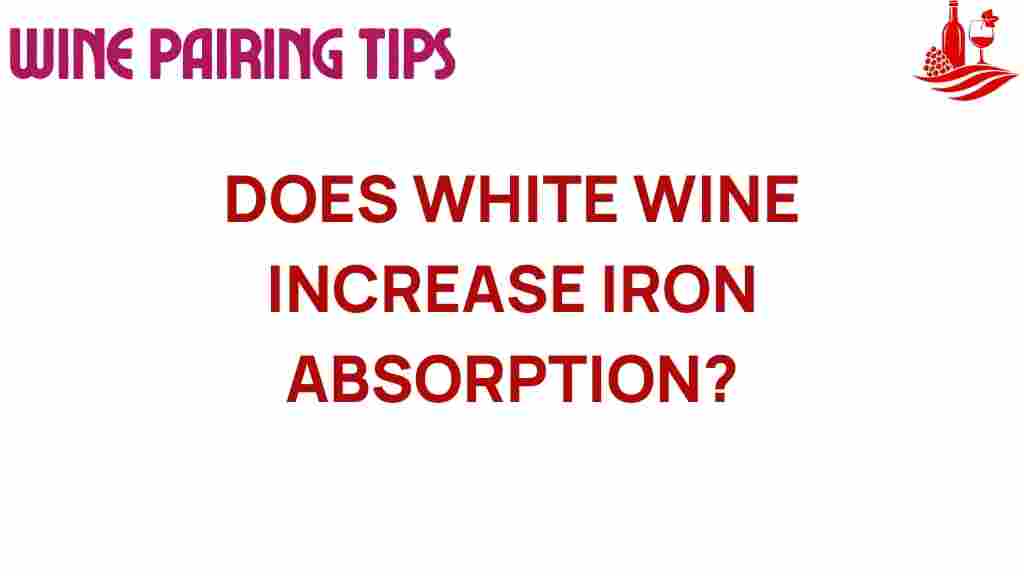Unveiling the Truth: Does White Wine Enhance Iron Absorption?
When it comes to nutrition, people are often bombarded with information that can be confusing or misleading. One topic that frequently arises in discussions about dietary choices is the relationship between white wine and iron absorption. This article aims to dissect the claims surrounding white wine, explore its potential health benefits, and address common wine myths related to iron absorption. We will also touch on the nutritional aspects and antioxidants found in wine, assisting you in making informed dietary choices.
The Science Behind Iron Absorption
Iron is a crucial mineral in our bodies, playing a vital role in various functions, including:
- Transporting oxygen in the blood
- Supporting immune function
- Contributing to cognitive development
There are two types of dietary iron: heme and non-heme. Heme iron, found in animal products, is absorbed more efficiently than non-heme iron, which comes from plant-based sources. Factors that influence iron absorption include:
- The form of iron in the food
- Other dietary components, such as vitamin C, phytates, and polyphenols
- Overall health and nutritional status
White Wine and Iron Absorption
Now, let’s delve into the primary question: does white wine enhance iron absorption? White wine, like other wines, contains certain compounds that may affect how our bodies absorb iron.
Some studies suggest that the polyphenols found in wine, particularly flavonoids, can influence iron absorption. Polyphenols can bind to non-heme iron and inhibit its absorption, which could potentially lead to lower iron levels in those who consume wine regularly with meals rich in non-heme iron.
Health Benefits of White Wine
While the relationship between white wine and iron absorption might be complex, it’s essential to consider the overall health benefits associated with moderate wine consumption. Some potential benefits include:
- Rich in Antioxidants: White wine is a source of antioxidants, which can help combat oxidative stress and inflammation in the body.
- Heart Health: Moderate consumption of white wine has been linked to improved heart health, potentially reducing the risk of cardiovascular diseases.
- Social Enjoyment: Drinking wine in moderation can enhance social interactions, contributing to mental well-being.
However, it is crucial to balance these benefits with the risks associated with alcohol consumption, particularly for individuals with certain health conditions or those who are pregnant.
Nutritional Profile of White Wine
To understand the implications of incorporating white wine into your diet, let’s examine its nutritional profile:
- Calories: Approximately 120-130 calories per 5 oz serving
- Sugar: Varies depending on the type (dry vs. sweet), ranging from 0-10 grams per serving
- Carbohydrates: About 3-4 grams per serving
While white wine does offer some nutritional value, it should be consumed in moderation. Excessive alcohol intake can lead to adverse health effects, including liver disease, addiction, and increased cancer risk.
Addressing Wine Myths
In the realm of wine myths, many misconceptions exist regarding the health impacts of wine, particularly concerning iron absorption:
- Myth #1: All wines are created equal.
In reality, different types of wine contain varying levels of polyphenols and antioxidants, which can influence health effects. - Myth #2: Drinking wine daily is healthy.
While moderate consumption may offer benefits, excessive drinking can lead to serious health issues. - Myth #3: Wine always enhances nutrient absorption.
This is not true for all nutrients; in fact, it may inhibit the absorption of certain minerals like iron.
Dietary Choices and Iron Sources
If you’re concerned about iron absorption, it’s essential to focus on your overall dietary choices. Here are some tips to enhance iron absorption:
- Pair Iron with Vitamin C: Foods rich in vitamin C, such as oranges, strawberries, and bell peppers, can enhance non-heme iron absorption.
- Avoid Tannins and Phytates: Limit the intake of coffee, tea, and certain whole grains during meals rich in iron, as they can inhibit absorption.
- Incorporate Heme Iron: Include sources of heme iron, such as lean meats, poultry, and fish, which are more easily absorbed.
Step-by-Step Process for Enhancing Iron Absorption
To effectively enhance iron absorption while enjoying white wine, follow these steps:
- Choose Iron-Rich Foods: Plan meals that include iron-rich foods such as spinach, lentils, and lean meats.
- Incorporate Vitamin C: Add a side of citrus fruit or a salad with bell peppers to your meal.
- Time Your Wine Consumption: If you choose to enjoy white wine, consider drinking it separately from meals high in non-heme iron.
- Monitor Your Intake: Keep track of your overall alcohol consumption and ensure it remains within moderate limits.
Troubleshooting Tips for Iron Absorption
If you’re experiencing issues with iron absorption, consider the following troubleshooting tips:
- Consult a Healthcare Professional: If you suspect iron deficiency, consult a doctor for testing and advice.
- Reevaluate Your Diet: Keep a food diary to identify potential inhibitors of iron absorption in your diet.
- Consider Supplements: If needed, discuss iron supplements with your healthcare provider.
Conclusion
In conclusion, the relationship between white wine and iron absorption is nuanced and dependent on various factors, including the types of food consumed and individual health status. While white wine contains beneficial antioxidants, it can also inhibit the absorption of non-heme iron when consumed with iron-rich meals. Therefore, it is vital to make informed dietary choices and consume wine in moderation. If you’re concerned about your iron levels, focus on incorporating vitamin C-rich foods and heme iron sources into your diet.
For more information on dietary choices and nutrition, check out this nutrition guide. If you want to explore the health benefits of antioxidants found in wine, visit this external resource.
Ultimately, understanding how white wine interacts with iron absorption can help you enjoy this beverage while maintaining optimal health.
This article is in the category Tips and created by Wine Pairing Tips Team
